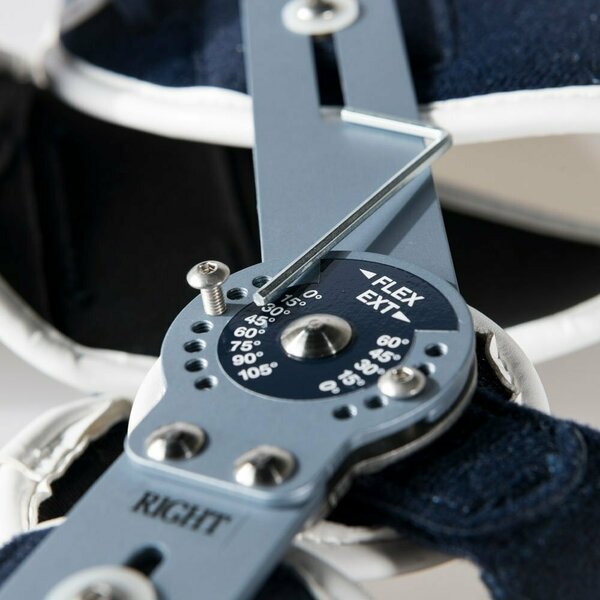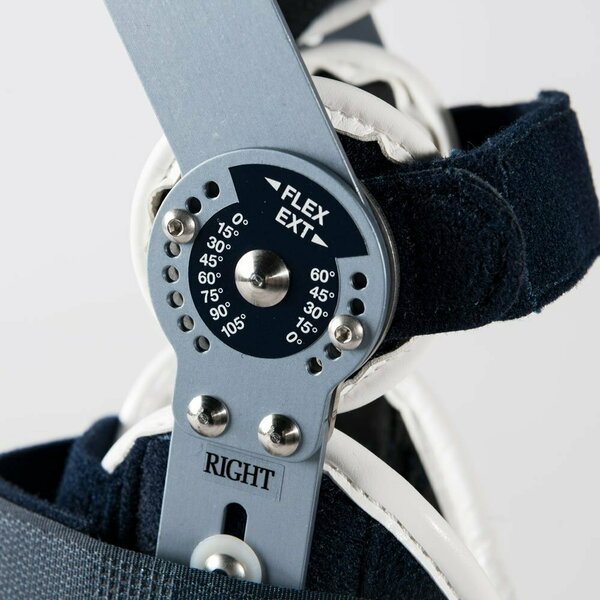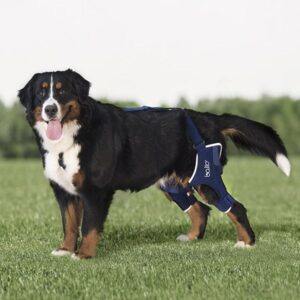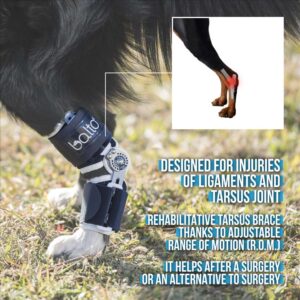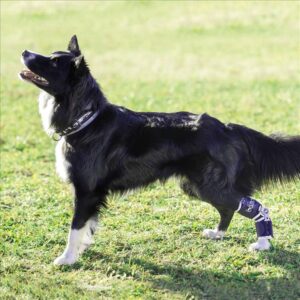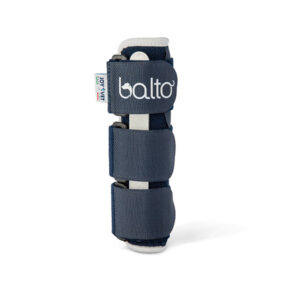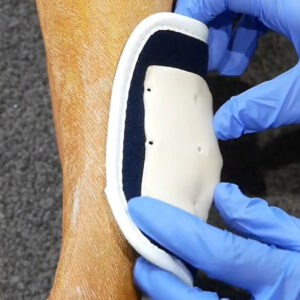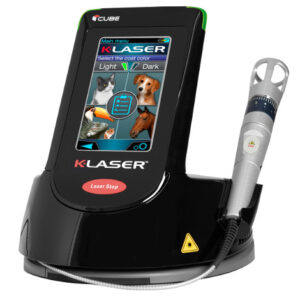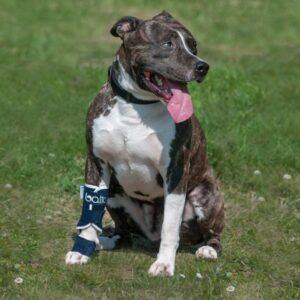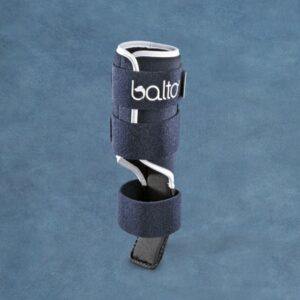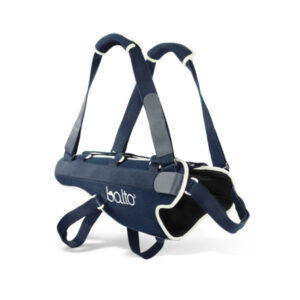Description
Balto – Adjustable Hinged Dog Knee Brace – BT LIGATEK
WHAT IS IT FOR
The Balto Adjustable Hinged Dog Knee Brace ‘BT LIGATEK’ has been designed for cases of cruciate ligament rupture (ACL), luxation of the patella, knee joint conditions such as arthritis and arthrosis.
The Balto Ligatek knee brace has been carefully designed to stabilize your dog’s post-op trauma or the reduction in the knee joint required. Thanks to the adjustable hinges, the user can control the R.O.M. (Range of motion) and lock the joint into full immobilization or controlled degrees of flexion-extension movements. This enables to treat a variety of needs in a versatile way. Ligatek is also width adjustable (thanks to our modifiable straps) as wellas length-adjustable. The upper and lower padding can be extended or shortened to ensure an excellent fit around the leg.
LIGATEK KNEE BRACE RECOMMENDED USAGE DURING POSTOPERATIVE CARE:
Thanks to Ligatek, the user can regulate flexion-extension movements or lock the joint into full immobilization, allowing proper healing by reducing stress and excessive strain, depending on your dog’s needs after surgery.
Ligatek is recommended for postoperative care in case of:
- Cranial-caudal cruciate ligaments deficiency (TPLO, TTA surgical procedures);
- Patellar surgical procedures (sulcopasty, tibial tuberosity transposition, fracture);
- Extracapsular technique;
- Patellar tendon synthesis.
LIGATEK KNEE BRACE CONSERVATIVE TREATMENT USAGE AS AN ALTERNATIVE TO SURGERY:
The ligatek brace can be used as an alternative support in cases when surgery options are not feasible (E.G. Due to age or prior medical condition). Being able to control movements while maintaining an adequate R.O.M.,
Makes ligatek suitable for conservative treatments such as:
- Cranial and caudal cruciate ligament injury and/or tear;
- Traumatic or acquired collateral ligaments deficiency;
- Joint capsule trauma;
- Patellar dislocation.
SIZES AND MEASUREMENTS
Important
Before proceeding with your purchase, please make sure you have taken the correct measurements on your dog as shown below.
If you have any doubts, please contact us by email and send us:
– measurements A, B, C
– weight of your pet
– breed of your pet
– A photo of your dog
Available in three adjustable sizes.
| Sizes | Circ. A | Circ. B | Lengths C | Breeds and weights* |
| S | 23-29 cm | 8-13 cm | 12-15 cm | Cocker Spaniel (10-20 Kg) |
| M | 26-31 cm | 10-16 cm | 14-18 cm | Border Collie, Setter (18-30 Kg) |
| L | 29-34 cm | 12-18 cm | 15-21 cm | German Shepherd, Golden Retriever, Rottweiler (28–50 Kg) |
| XL | Over 36 cm | – | 16-23 cm | Saint Bernard, Great Dane, Newfoundland (Over 50Kg) |
*Attention the suggested breeds and weights are purely indicative, to determine the size of the brace take the measurements as specified.
HOW TO TAKE THE MEASURES
Measure A: Measure the circumference of the dog’s thigh halfway between the groin and knee.
Measure B: Measure the circumference of the dog’s paw halfway between the knee and the hock.
Measure C: Measure the distance between the knee and the base of the hock.
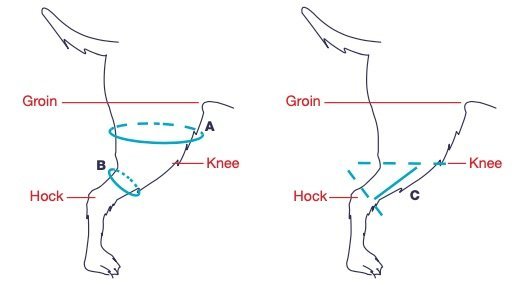
INSTRUCTIONS FOR USE
PROPER BRACE SETTING
The below settings must be adjusted on both sides before positioning the brace.
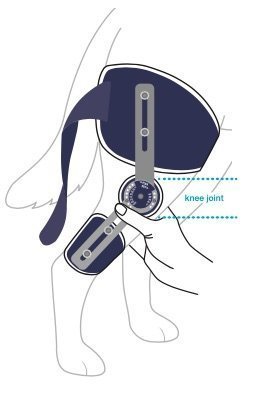
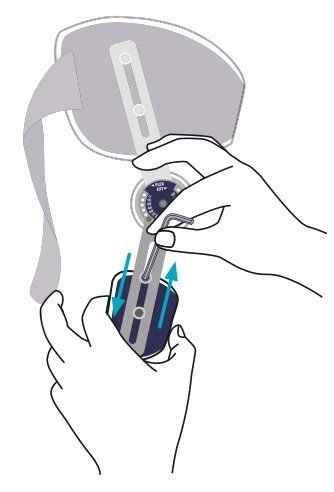

Warning: use the supplied Allen keys only. The use of screwdrivers could damage the screw thread.
for the lower padding to adjust the position of the UPPER PADDING.

Warning: the upper padding has been molded according to your dog’s anatomy; as a result, it rests lower on the inner thigh. When placing the brace on your dog, it is important to follow its natural shape.
ADJUSTABLE HINGE SETTING
The below settings must be adjusted on both sides before positioning the brace.
5. Once the proper length has been fixed, please proceed with setting the ADJUSTABLE HINGE by using the smallest Allen key.
30° flexion position (FLEX)
30° extension position (EXT)
* A total joint immobilization is recommended before surgery or under the veterinarian’s advice.
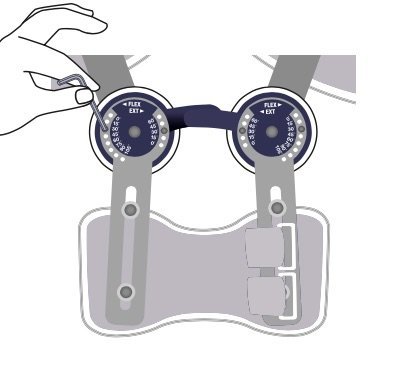
75° flexion position (FLEX)
30° extension position (EXT)
This is to prevent the risk of knee hyperextension or hyperflexion.
** Use this setting after surgery or when using the brace as an alternative to surgery.
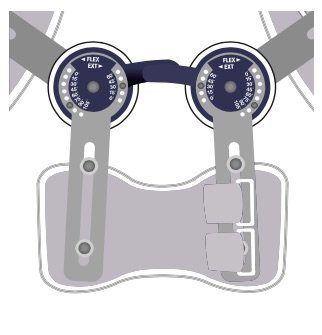
By moving the screws onto the different notches, the joint’s flexion and extension degree angle is either reduced or locked.
Warning: the use of any other settings, different from the above, may be used
during postoperative care or as an alternative to surgery under the exclusive responsibility of the VETERINARIAN.

BRACE APPLICATION
After adjusting the brace’s length and the central hinge’s degrees, please proceed with positioning the brace on your dog’s leg.
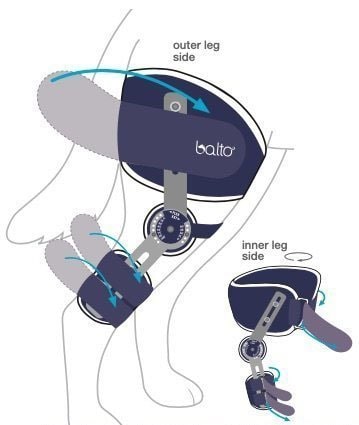
* The middle strap stabilizes the two central hinges during flexion as they tend to open slightly. If the veterinarian does not deem it as essential, it can be cut, leaving the central part of the brace free.
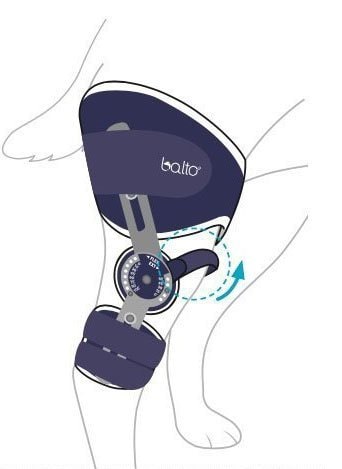
Warning: be careful not to cut too much, otherwise the Velcro will not fasten properly.
* The brace is equipped with sufficiently long bands suitable for oversize or overweight dogs.

RECOMMENDED USE
- During postoperative care please follow your veterinarian’s instructions on appropriate usage time. In case of postoperative edema remove the brace until the swelling is reduced.
- Do not remove the stickers showing the hinge degrees and the brace direction.
- Keep the brace clean. Eliminate any hair, especially inside the Velcro parts:
use an appropriate hairbrush every 2/3 days. - Do not machine wash the brace: for proper cleaning remove all padded parts and hand wash them in cold water with mild detergent.
- Do not use screwdrivers or other electrical tools to adjust the screws.
- Do not force the screws during assembly to avoid damaging the thread.
In addition to the 2 allen keys, the package contains a few spare screws. - Do not leave the brace on for an extended period of time: the brace must be worn during the day, especially during physical activity, and it should be removed at night.
- Do not leave your dog unattended for a long period of time while wearing the brace: your dog could try to remove it by biting or scratching the brace.
USEFUL INFORMATION
RECOMMENDED ACTIVITY LEVEL
Your pet is in a recovery period so he/she cannot do as much and as long as before their cruciate tear injury. The healing is slow and depends on the level of activity of your dog. Once the knee is stable (surgery or knee brace) the key to a full, strong recovery is to do as much exercise as possible to prevent muscle wastage but while avoiding pain and a flare-up.
Ideally, look for a canine rehabilitation practitioner with a CCRP or CCRT qualification. They will establish a specific protocol and home exercise program according to your dog’s specific needs and level of recovery.
The level of exercise needs to be progressive.
It is safe to start with slow walks on a short lead for 5 minutes twice a day (straight lines on flat ground is best) then increase the time and type of ground. For small breeds who like to speed up on 3 legs, walking on gravel will slow them down. Weight-shifting exercises are an easy way to remind your dog that they can trust their leg again.
While your dog is standing (brace ON), place your hands around her/his rear then gently push the bottom from left to right very slowly so your dog will have to put their weight on each leg, shifting their weight from side-to-side.
Hydrotherapy is fantastic but swimming is a very fast motion that could damage the joint if done too soon. Start with walking in water first. Please control the playtime with other dogs or yourself. We recommend that your dog does not jump or run for 1 to 3 months.
FACTORS ACTING ON HOW LONG TO USE THE KNEE BRACE
- The tear can be partial or total
- There is the possibility of other damage present in the leg (collateral ligament, meniscus injury, patella luxation, sprain/strain on the hip back or hock)
- The weight of your dog is another variable. Small breeds less than 10kg tend to improve faster than larger breeds or overweight dogs
STATISTICS WHEN USING THE BALTO LIGATEK as an alternative to surgery
The scar tissue that will stabilize the stifle needs 1 to 3 months to build up in order for the dog to walk without a brace.
During this first period, we advise you to use the brace every time the dog is active. Remove it at night or when the dog is resting.
After this initial period, the scar tissue needs another 6 months to consolidate and be strong enough to bear the full weight of an active (running, jumping, turning) pet without the brace. During this second phase, you can use the brace only during times of increased activity (e.g. in a dog park or on long walks)
- It is very common for a dog to develop a cruciate injury on the second leg after the first one.
- Keep in mind that the brace provides support externally so it is still possible for the dog to chew and scratch it. Therefore we recommend to remove it when you leave the dog alone.
- Like for any bandages, casts or braces, rubbing against the skin can happen. Please check your dog’s skin twice a day where it contacts the brace.
A rubbing area indicates a fitting issue. Slacken the straps if required and reduce the amount of time that your dog wears the brace to allow healing of the irritated skin. - As your pet has the potential to damage the brace or injure itself, we recommend the supervision of your dog at all times when wearing the brace.
ADAPTATION PERIOD
- Most dogs get used to the knee brace very easily within a few minutes or hours.
- If not then check the fitting again and help your dog with some exercises.
- The weight-shifting exercise described in the section above is ideal.
- Be sure to provide lots of treats and rewards when the dog is wearing the brace for encouragement.
- Start progressively, only wear the brace for 15-minutes intervals at the beginning, several times on the first day. Then increase this to 1h, then 2h 3-4 times a day the following days.
UNDERSTAND THE CRUTIATE INJURY AND TREATMENT OPTIONS:
WHAT IS A DOG CRUCIATE LIGAMENT INJURY?
The rupture of the cruciate ligament means that the knee joint of your pet is unstable. The instability is triggered each time the dog bears weight on the leg. In the short term, the injury is painful and can be swollen, then a lack of activity leads to muscle wastage (atrophy). Within the time frame of a few months to a few years, the long term consequences of this instability are the onset of osteoarthritis.
PRODUCT VIDEO



